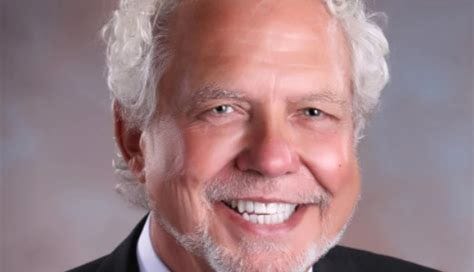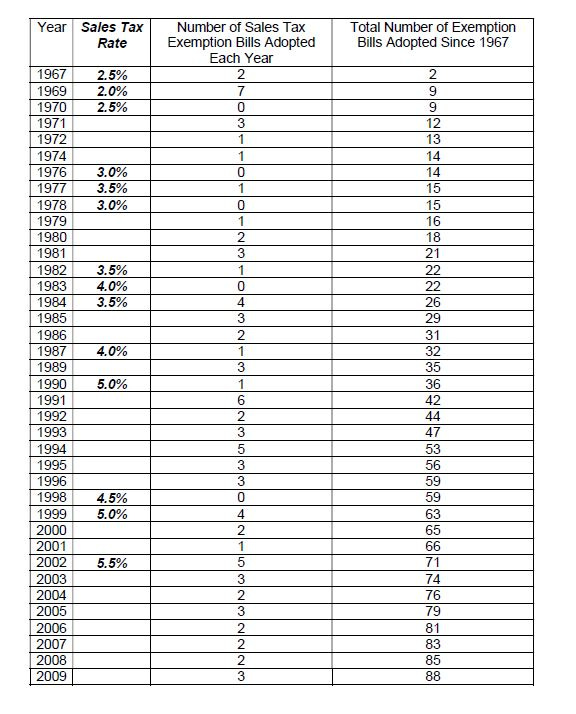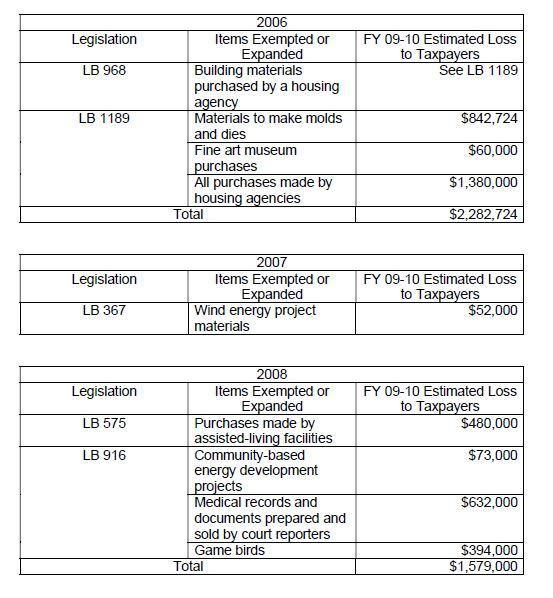Update II: Nebraska Examiner takes notice of same problem (https://nebraskaexaminer.com/2024/06/10/everybodys-got-to-play-breaking-down-nebraskas-more-than-100-sales-tax-exemptions/)
Update: Pahl’s document can now be downloaded from Dropbox at
Short link at https://tinyurl.com/mr9yfz6p
Rich Pahls was a Nebraska State Senator and died a few years ago (https://en.wikipedia.org/wiki/Rich_Pahls). When one of his colleagues offered a tax exemption, I told Pahls to oppose it and a discussion ensued. I presume others told him the same and he put out a paper on the topic from about 2009. I saved it as PDF but replicate it here. God bless Rich Pahls. Special thanks to Kathy Holkeboer, of the Voter Information Project (https://www.voterinformation.org/) for prodding me to trace down this very important document.
Repeal Sales Tax Exemptions and Eliminate or Lower Other Taxes and Fees
Information Packet
Senator Rich Pahls
State Capitol
Lincoln, NE 68509
402/471-2327
rpahls@leg.ne.gov
The Big Picture:
Why Tax Exemptions Make a Big Difference
Our three big taxes in Nebraska are property taxes, income taxes,and sales taxes. How much does each raise annually?
Property taxes: $2.5 billion
Who pays?: All property owners
Who sets the rates?: Local governments
Who collects? Local governments (state government gets
nothing)
Who spends? Local governments (state government gets
nothing)
Income taxes: $2 billion
Who pays?: Income earners
Who sets the rates?: Legislature
Who collects? Department of Revenue
Who spends? Legislature
Sales taxes: $2 billion
Who pays?: Certain buyers
Who sets the rates?: Legislature and local governments
Who collects? Department of Revenue
Who spends? Legislature and local governments
Value of sales tax exemptions: $3 billion and growing
You can easily see that if we eliminated sales tax exemptions, we
could use the revenue to completely overhaul our state tax system.
Here are some options: We could eliminate all property taxes and
lower the income tax. We could eliminate the income tax and lower
property taxes. We could lower sales tax rates. We could do a
combination of all the above.
If we didn’t want to eliminate all of the exemptions, but eliminated the
big ones, we would still have enough revenue to make a substantial
impact on other tax rates.
State Sales Tax Rates from 1967 to Today
When the Legislature first enacted a state sales tax in 1967, the
rate was 2.5%.
Today the state sales tax rate is 5.5%. Cities and counties are
authorized to add up to an additional 1.5% on top of the state
rate.
Sales tax exemptions are part of the reason that sales tax rates
have been raised over the years. Each time an exemption is
added, its fiscal impact continues to grow. Over time the sales
tax rates become inadequate--they do not generate the same
amount of revenue--and the Legislature raises the rates again,
rather than going back and closing the loopholes. Certain
groups get exemptions and the remaining taxpayers pick up the
slack through increased tax rates.
Cities and counties that have a sales tax suffer the same loss
and are forced to raise their rates to the maximum 1.5%. Now
we see cities asking the Legislature to raise the maximum local
rate to 2%. In the meantime cities look at raising the tax on
restaurants 4%.
The following chart illustrates the effect exemptions have on the
state sales tax rate. A similar impact occurs on local sales tax
rates. Many bills that were adopted contained more than one
exemption when they passed.
2009 Sales Tax Exemption Legislation Adopted
The 2009 session started out with a total of 15 bills proposing various sales tax exemptions. Three bills passed that created new sales tax exemptions or that expanded current exemptions. The total knownfiscal impact for these three bills is:
FY2009-10: ($158,400)
FY2010-11: ($232,100)
FY2011-12: ($264,900)
FY2012-13: ($292,900)
LB 9 Exempt sales of wood and corn used as fuel and mineral oil applied as a dust suppressant
Fiscal impact (loss to state taxpayers) on the wood and corn portionof the bill
FY2009-10: ($36,400)
FY2010-11: ($38,100)
FY2011-12: ($39,900)
FY2012-13: ($41,900)
Fiscal impact (loss to state taxpayers) on the mineral oil portion ofthe bill:
FY2009-10: ($122,000)
FY2010-11: ($194,000)
FY2011-12: ($225,000)
FY2012-13: ($251,000)
LB 392 Exempt learning communities from paying sales tax
Fiscal impact: unknown. (No fiscal estimate was ever made or
attempted.)
LB 587 Exempt animal grooming services done in conjunction with veterinary
services
No fiscal impact. (This estimate could be disputed. The Department
of Revenue was attempting to collect the tax, but the Legislature
chose to exempt it instead.)
Sales Tax
Exemption Bills Passed in 2006 to 2008
2009 Nebraska Supreme Court Ruling on Sales Tax Exemptions
On June 5, 2009 the Nebraska Supreme Court handed down a ruling
that created another new sales tax exemption. (Concrete Indus. v.
Nebraska Dept. of Rev., 277 Neb. 897)
The Legislature exempted the sale of manufacturing machinery and
equipment in 2005 (but not parts for machinery and equipment). In
2007 Concrete Industries purchased various parts that it used to build
its own manufacturing machinery and equipment. When it purchased
the parts, the Concrete Industries paid sales tax. Concrete Industries
filed a claim with the Nebraska Department of Revenue for a refund,
stating that the purchases should be tax exempt under the law
adopted in 2005 by the Legislature that granted an exemption for
manufacturing machinery and equipment. The Revenue Department
denied the claim. Concrete Industries challenged the Revenue
Department’s decision and the case ultimately moved its way up to
the Supreme Court for a final determination.
In its ruling, the Supreme Court reversed the department’s denial of
the claim and required the department to refund the sales tax to
Concrete Industries. The court, in its ruling, said, “…it would make
very little sense to exempt assembled machinery from sales and use
taxes, and to exempt each and every part of that machinery from
sales and use taxes if it is purchased to replace an original part, but
to impose a tax on the purchase of the same parts when they are
purchased to assemble the machinery in the first place.” (page 905)
“We hold that…the “sale . . . of manufacturing machinery and
equipment” includes the sale of items that are assembled to make
manufacturing machinery and equipment.” (page 906)
As a result of this ruling we can now add an additional sales tax
exemption to the list started by the Legislature.
If the Legislature continues down the road of granting more
exemptions we place our Department of Revenue in a precarious
position. This past session some senators criticized the Department
for not collecting sales tax in some areas. Then the Legislature
turned around and passed legislation to grant the exemption.
In the Concrete Industries case the Department tried to make sense
of the various loopholes the Legislature created and it sought to
collect the tax. The Court considered all the loopholes the Legislature
created and said it didn’t make any sense to grant exemptions on
manufacturing machinery and equipment but not on the individual
parts if a company chose to buy the parts individually and construct
its own equipment. What’s next?
It’s bad enough when the Legislature grants exemptions, but now we
have put our Supreme Court in the position of granting them. The
Legislature needs to take back its responsibility from the court and
close these loopholes. We do not know the cost of this ruling yet.
Supreme Court opinions don’t come with fiscal estimates.






While taxes and the exemptions are a big deal per the article. The bigger problem in my opinion is spending. So many people/organizations have their tin cup out rattling it for dollars that the state cannot or will not say NO! These panhandlers use the compassion argument to justify their state enforced theft.
Once the government is enlisted to be the muscle in this theft ring the theft never stops. We have all heard and said taxes are too high since we entered the workforce. Very seldom is spending attacked, its always justified for the children, for this or that. These groups recruit government to be their thugs, they don't have the brass to steal on their own so they recruit government to do their thuggery work.
We've all heard the emotional arguments justifying this theft. I counter - Can anyone tell me what is compassionate about stealing from one at the point of a gun and giving to another?